(Revell conversion)
[ Page 1 ]
1/32 scale Hunter mk4. through conversion of Revell kit
The Revell kit (no.04703) of the Hunter FGA.9 / Mark 58 was issued in 1996 and was really welcome as being the first ejection moulded kit in this scale.
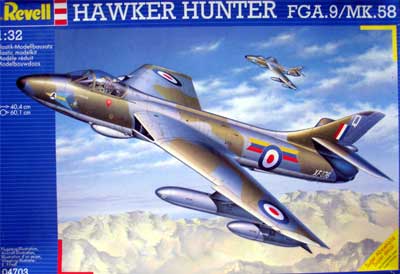
The kit is very good and well researched being accurate as well as having good outlines and good fit. It can be improved in some small areas; this will be covered in this modelling report. Parts have finely engraved panel lines and the intake and cockpit are captured very well.
To cater for the FGA.9 or mk 58 version, you get several extra parts. Basically the exhaust pipe has the parachute housing and is the pipe with the largest diameter as the engine was the most powerfull fitted. Stores are also provided for the 100 gallon and larger 230 gallon tanks, rocket pods and the "sabrinas" under the forward fuselage.
The parts for the Swiss version are also very well researched with extra details on pylons and airframe such as antennas.
The kit's decalsheet is very good
with decals provided for 2 RAF and 2 Swiss Air Force planes. Markings for
the RAF are for FAG9 Hunters of 208 squadron in Kuwait 1961 and 45
squadron at Wittering 1976. The Swiss mk58 markings are for "Patrouille
de Swiss" at Dubendorf 1991 and Fliegerstaffel 20 at Mollis airbase 1993.
All planes have a camouflage scheme.
![]()
This model of the Hunter will be
converted into a EARLY mk.4 with markings to be added of a Hunter of the
Royal Netherlands AF Hunter of the sixties. See for a brief Hunter history
the
main page here.....
For the mk.4 conversion the main changes to this kit are:
A. Wing without saw tooth for the original early mk.4 variant;
B. Smaller exhaust pipe also without the parachute housing
C. Changes in cockpit, mainly on the main instrument panel
D. Change in ejection seat
E. Split trailing edge flap without tank cut out (for mk.4 and mk.6 planes, the larger fueltanks were not used; these were typical for FGA9 and later variants)
F. New markings (as you wish)
Lets follow
a step of step approach, referring to the Revell assembly instructions
steps......
Please note
that the STEP numbers are based on this kit's instructions (so the FGA9/mk.58
kit #0389). You can also use the mk.6 kit, but their STEP numbers are different!
Please refer than to the mk.6 modelling report for an idea on these STEP
numbers).
An aluminium coat was put onto the gear legs, some smaller parts and undercarriage bays.
![]()
Now on to assembly....
STEP 1+2
The ejection seat of the kit is quite
nice, but the Mk.4 of the RNeth AF used the Martin Baker 3H seat which
is not in the kit. (Revell made an error here: in the FGA9 kit, it is actually
a 3H seat for which parts are provided and not a 2H as indicated in the
instructions).
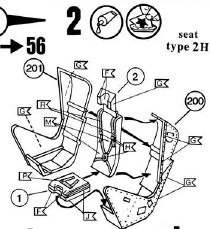
The 2H seat has "higher curved" plates
on the sides. You thus only need to make a small modification if you have
the 04703 kit. Alternatively you can buy aftermarket resin seats. LOOK
HERE FOR MORE SEAT INFO....
STEP 3
The main instrument panel of the
mk.4 seems to have a similar layout as that of the F.mk.6. I could not
find big differences. Below you see a mk.4 panel:
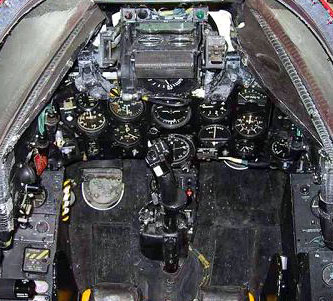
..
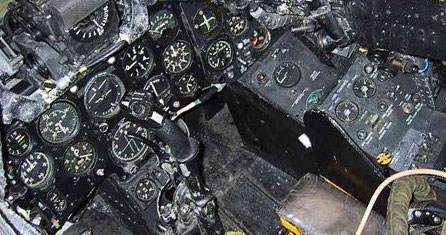
I think you can use the Revell part
provided.

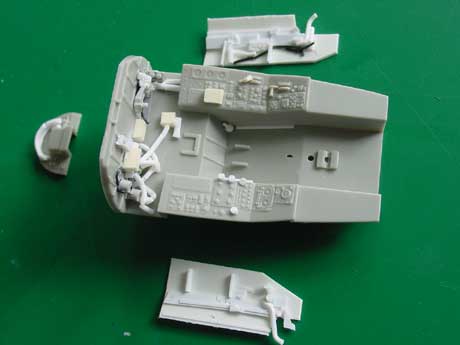
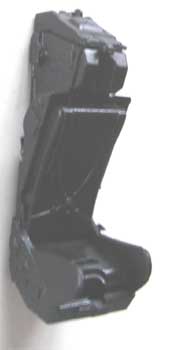
Overall the cockpit is well detailed.
I only added side panels and some tubing and a more pronounced throtlle
levers from sprue. As I also had purchased a TRUE
DETAILS cockpit detail set (NO. 32453 ) for the ECHELON kit. The
TD set is for a F.mk.6 , but again no large differences could be found
between the mk.4 and mk.6 cockpits. So details were added to the Revell
parts such as the tub using the resin set as an example. (NOTE: The TD
set has the MB 2H seat ).
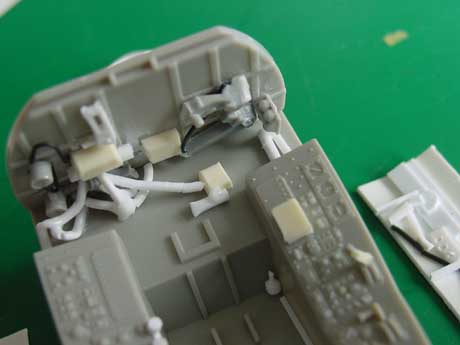
STEP 4+5
The overall colour of the Hunter
cockpit is "black" as common for fighter types of that period. A dark grey/black
mix was used including drybrushing to show of the detail and to prevent
a "coal hole". (obviously do not fit the seat yet). I did not fit part
#15 until later.
STEP 6
I filled up the hole in part #19
for the RNeth AF Hunter mk.4. Assemble as shown.
STEP 7
The nose gear unfortunately needs
to be fitted to be a strong assembly. Add a piece a card to close the gear
well.
Skip STEPs 8+9
STEP 10
Rear fuselage can be assembled, make
a cut in the lower rudder edged to show it better.
STEPs 11, 12 and 19
The internal intake is a very nice
feature. Fill the ejector pin marks in parts #25 + 26, paint and assemble
as shown.
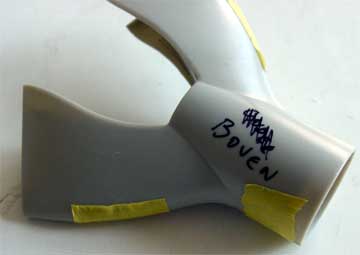
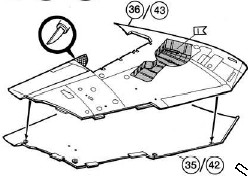
STEP2 13, 14, 15 and 16
CONVERSION FOR MK.4:
A. WING
For an early
mk.4 the saw tooth should not be present on the wing leading edges.
I simply removed
plastic from the rear of parts #38+ 37 and 44+45. These parts can than
be "blended in" the main wing. Use filler as needed to get an overall smooth
result. You will also need to modify a bit the wingtip parts #40 and #47.
Sanding will do the work here but make sure to keep openings for the wing
tip lights.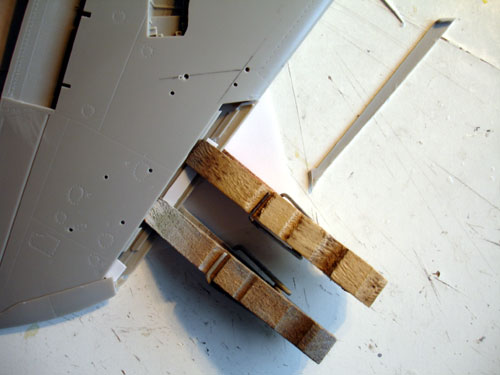

mk.4
conversion for the wing leading edges.
Also add now the wing tip lights as
they need some trimming as they are a bit too large.
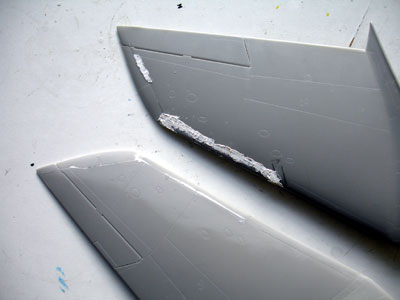
A note on STEP
15: the openings are not needed for the stores. However, the openings for
the inner pylons (see STEP 46 or 47) for the 100 gallons tanks are too
far outboard and should be positioned 2 mm and in parallel with the leading
edge in 1/32 scale more inboard! This will improve the look of the Hunter
model.
Make new holes
and fill up the incorrect holes.
B. FLAP ADAPTION
Finally the
trailing edge droop flap (parts # 41 and 48) have a small cut-out for the
larger wing tanks. On the mk.4 these were not present. Simply cut of the
corner of the lower wing halve and reposition onto the flap. Fill and sand.
C. FUSELAGE
GRILLS ADAPTION
The mk.4 had
a different engine than the mk.6. On the mid upper fuselage you will find
a different configuration on the grills and small auxiliary intakes for
the engine.
I used the
drawing from the Echelon kit instructions. Most upper grill and intakes
on the part # 23+24 were filled and new ones cut open and inscribed. Putty
was used to fill up the not relevant kit details.
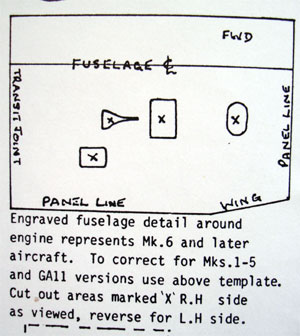
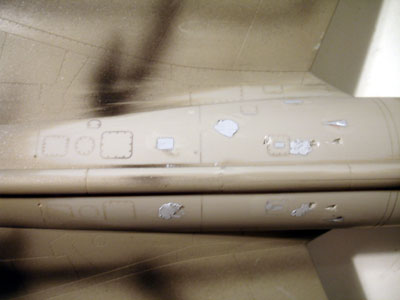
STEP 17, 18
Assemble stabilizers as shown, but I had to thin down the attachment lips. On the outside edges you may need some filler on the edges.(Do not fit yet to the main assembly). (do not fit wing yet).
Skip STEP 20.
STEP 21
This is a very important stage in
the model construction. Do this step in two parts!
First join the rear fuselage from
step 10 to the front section of step 8. (leave instrument cover #20 for
later). Than add the part # 7 from step 8 and glue in place.
NOTE: you may open up the gun ports as you wish. Look at pictures of the particular Hunter you want to model. Gun gass deflectors of different shapes may be seen on Hunters, but are often not fitted to mk.4's. (The Revell parts #139-141 are typical for the mk.58).
After the main fuselage has cured,
add the nose but make sure to add weight as indicated in Step 9.
DO NOT FIT WING HALVES YET!
CONVERSION FOR MK.4:
D. EXHAUST PIPE
As a mk.4 model
was to be made, a smaller diameter tail pipe was needed and the Revell
parts #32,33,34 are not useable.
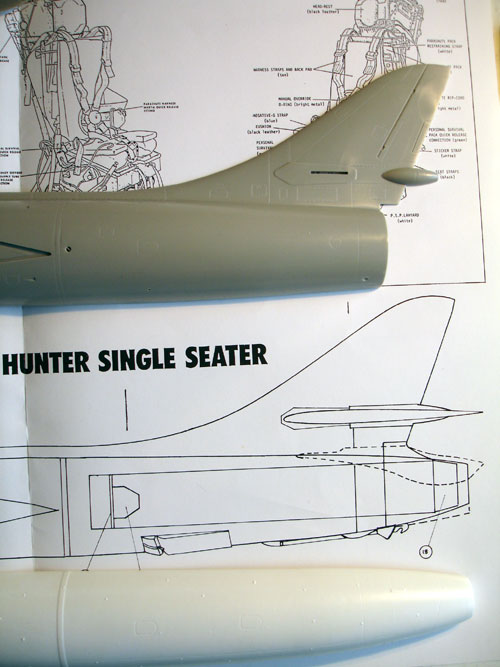
For the mk.4
tail pipe I used the
ECHELON kit vacuform parts.
The ECHELON kit has the two halves of the exhaust moulded on the main fuselage
halves. They were cut off with a razor saw after the vacuform parts were
separated from their backing sheet. The cutt was made 32 mm from the rear,
so the length of the tail exhaust is 32 mm. Simply add these parts to the
Revell rear fuselage.
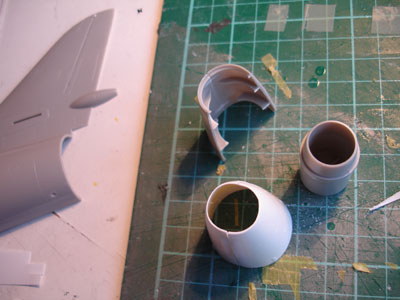
As you will
see, the vacu parts will fit the Revell kit quite easily. If you do not
have a spare ECHELON kit you may try to create the smaller exhaust yourselve
from card. Maybe you can try to make a cone from thin card although it
is not simple as it should taper to the rear; for your information:
the rear diameter of the mk.4 exhaust should be 16 mm externally. Obviously
at the front it should match the Revell fuselage.
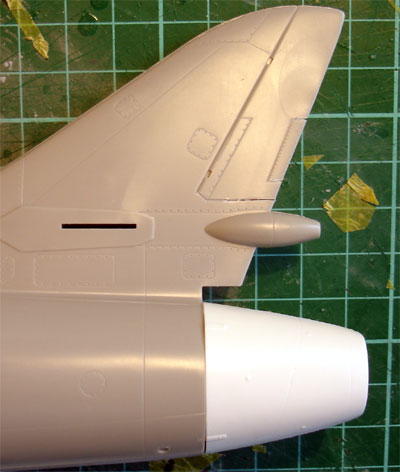
For the mk.
4 engine tail pipe part #34 was simply re-used, but it was moved more to
the front of the tailcone.
I also had to
make the small curved fillet as seen here with card. It was puttied and
sanded.
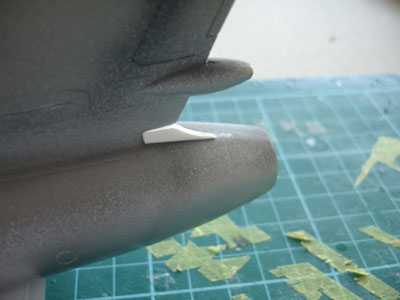
Next....
Sand and putty the whole fuselage with exhaust + main + front sections as needed now as you can now easily handle the fuselage.

The overall fuselage is now ready for further taking on the modified wings.
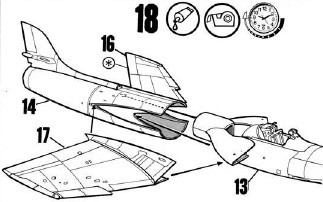
Refer to Revell instructions STEP 20 and STEP 21 to assemble the wings to the fuselage. You will find that it may be necessary to cut off some of the plastic thickness sligthly on the insides of the parts on the forward bend edges of the wing intake gloves to get a snug fit. I also had to remove 1 mm on the rear wing root junction.
The inner intake can be snugly glued into the wing intake gloves.
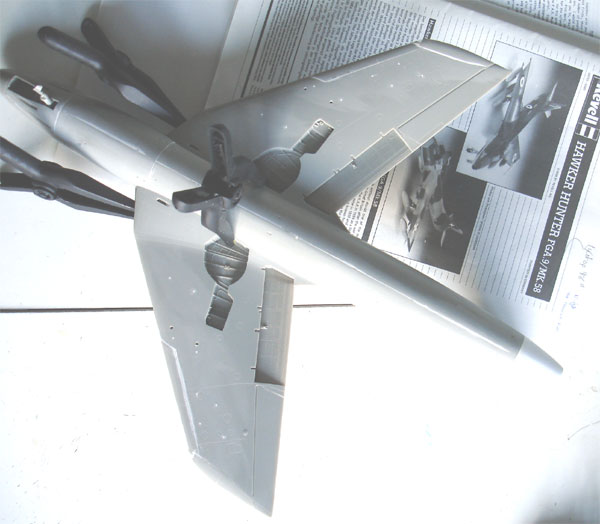
STEP 24
Assemble the upper spine, no hole drilling needed. I left off the stabilizers until later.
On to next [ Page 2.... ]
![]()
Back to Hunter main page
Back to 1/32 Models.......

(c) Copyright Meindert "designer"/ All rights reserved. Your comments are welcomed by webmaster
Created this page December 28, 2006